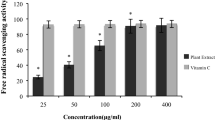Abstract
Gastroprotective is an effect caused by the compounds that have the capability of protecting the gastric mucosa. Peperomia pellucida L. plants contain alkaloids, flavonoids, saponins, tannins, and terpenoids, while Pachyrhizus erosus L. contains flavonoids, alkaloids, tannins, and saponins. Peperomia pellucida L. reportedly contains dillapiole compounds with a gastroprotective effect. Moreover, its isolation result from Pachyrhizus erosus L. indicates the presence of dulcitol, gentisic acid, and formononetin, which has antioxidant activity. This study aims to determine the gastroprotective effect of the combination of Peperomia pellucida L. and Pachyrhizus erosus L. extract on rats with gastric ulcer models by looking at the ulcer index, percentage of inhibition, and histopathology. The research method used in this study was by making a combination of Peperomia pellucida L. and Pachyrhizus erosus L. extract. The combined extract was then given to five treatment groups. Group I as a negative control, group II as a positive control was given sucralfate, groups III, IV, and V were given a combination of Peperomia pellucida L. and Pachyrhizus erosus L. extract of 100, 200, and 400 mg/kg BW. The treatment was given orally for 14 days, after 1 h of treatment on the 14th day, 96% ethanol induction was given orally at a dose of 5 mg/kg BW. The animal dissection was performed 24 h after the induction. The results from observations showed an increase in body weight before and after the treatment. The ulcer index produced by negative control, positive control in the treatment with doses of 100, 200, and 400 were 4.18; 2.98; 2.42; 2.04; and 1.07. This study showed that the combination of Peperomia pellucida L. and Pachyrhizus erosus L. extract has a gastroprotective effect.


Similar content being viewed by others
Data availability
To avoid plagiarism, the datasets generated during and/or analysed during the current study are not publicly available but are available from the corresponding author on reasonable request.
References
Brunton LL, Lazo JS, Parker KL (2006) Goodman & Gillman’s the pharmacological basis of theurapeutics. McGraw Hill, New York
Ebadi N (2007) Pharmacodynamic basic of herbal medicine. CRC Press, London New York-Washington D.C, p 726
Indraswary R (2011) Effects of concentration of fennel fruit extract (Foeniculum vulgare Mill) Topical on Epitheliization of Wound Healing Gingiva Labial Rat Sprague Dawley in Vivo. Majalah Ilmiah Sultan Agung 49(124):1–14
Jaiswal V, Chauhan S, Lee HJ (2021) The bioactivity and phytochemicals of Pachyrhizus erosus (L.) Urb.: a multifunctional underutilized crop plant. Antioxidants 11(1):58
Kalogeromitros D, Makris M, Chliva C, Aggelides X, Kempuraj D, Theoharides TC (2008) A quercetin containing supplement reduces niacin-induced flush in humans. Int J Immunopathol Pharmacol 21(3):509–514
Longo DL, Fauci AS (2010) Harrison’s gastroenterology and hepatology. The McGraw-Hill Companies Inc, New York
Lukitaningsih E (2009) The Exploration of Whitening and Sun Screening Compounds in Bengkoang Roots (Pachyrhizus erosus). Thesis. Deutschen Akademischen Austauschdienstes) Wurzburg
Pertiwi R, Hanuun A, Kurniawati N, Siti Khodijah P, Fita Lestari D, Fitriani D, Notriawan D (2021) The effect of Raphanus sativus and Pachyrhizus erosus juice combination on the ethanol-induced gastric of mice. Pharmaciana 11:312–320. https://doi.org/10.12928/pharmaciana.v11i3.20104
Pertiwi R, Saputra HM (2019) The effect of bengkuang bulbs (Pachyrhizus erosus L.) on the histopathology picture of the gastric of Mencit (Mus musculus L.) with a peptic ulcer model. Jurnal Farmasi Dan Ilmu Kefarmasian Indonesia 5:56–61. https://doi.org/10.20473/jfiki.v5i22018.56-61
Rachmawati F, Rantelino V (2018) Scientific rampage flowers FK UKI (Nomor 7). Fakultas Kedokteran Universitas Kristen Indonesia, Jakarta
Rojas-Martínez R, Arrieta J, Cruz-Antonio L, Arrieta-Baez D, Velázquez-Méndez AM, Sánchez-Mendoza ME (2013) Dillapiole, isolated from Peperomia pellucida, shows gastroprotector activity against ethanol-induced gastric lesions in Wistar rats. Molecules 18(9):11327–11337
Roslida AH, Aini NZ (2009) Evaluation of gastroprotective effect of the ethanolic extract of Peperomia pellucida (L) Kunth. Pharmacologyonline 2:678–686
Saptarini MN, Suryasaputra D (2011) Analysis of Pepino cider antiulser protection ratio (Solanum muricatum Aiton) using mice as a model of animal trial. Majalah Obat Tradisional 16(2):75–80
Sipponen P, Maaros HI (2015) Chronic Gastritis. Scand J Gastroenterol 50(6):657–667
Souza FH, Jesus NZ, Gomes IF, Almeida LTJ, Morais Lima GR, Barbosa Filho JM (2012) Tannins, peptic ulcers and related mechanisms. Int J Mol Sci 13(3):3203–3228
Tan KC, Lyman SB, Wisner JD (2002) Supply chain management: a strategic perspective. Int J Oper Prod Manag 22(6):614–631
Tarigan P (2001) Tukak Gaster. Buku Ajar Penyakit Dalam. Pusat Penerbitan Fakultas Kedokteran, vol 1, pp 338–344 (Jakarta)
Widyaningsih W, Afdaliah SN, dan (2020) Gastroprotective effect of green algae extract (Ulva lactuca L) on gastric rats. Indones J Pharm Sci Technol 7(2):73–80
Acknowledgements
The authors would like to thank those who have helped a lot in this research. The deepest gratitude is addressed to Institute for Research and Community Service, University of Bengkulu, for the opportunity given so we could carry out this university development research with contract number 1811/UN30.15/PG/2021.
Funding
This work was supported by the University of Bengkulu (UNIB) on the theme contract number 1811/UN30.15/PG/2021.
Author information
Authors and Affiliations
Contributions
RP: contributed to the main study’s conception and design. Material preparation was permormed by SPYS and AGS. RP, AH, NKW, TP, DN, and RHW: collected and analyzed data. The first draft of the manuscript was written by RP, and all authors commented on previous versions of the manuscript. All authors read and approved the final manuscript.
Corresponding author
Ethics declarations
Competing interests
The authors have no relevant financial or non-financial interests to disclose.
Ethics approval
This study was performed in line with the principles of the International Association for the Study of Pain (IASP) Guidelines for the Use of Animals in Research. Approval was granted by the Ethics Committee of the University of Bengkulu (18 Oct 2021/No: 240/UN30.14.9/LT/2021).
Additional information
Publisher's Note
Springer Nature remains neutral with regard to jurisdictional claims in published maps and institutional affiliations.
Rights and permissions
About this article
Cite this article
Pertiwi, R., Samudra, A.G., Wati, N.K. et al. Gastroprotective activities of Peperomia pellucida L. and Pachyrhizus erosus L. extracts combination on ethanol-induced rats. Inflammopharmacol 30, 2139–2144 (2022). https://doi.org/10.1007/s10787-022-00982-4
Received:
Accepted:
Published:
Issue Date:
DOI: https://doi.org/10.1007/s10787-022-00982-4




